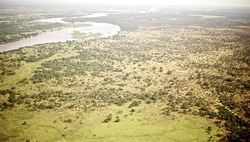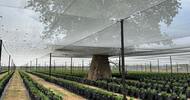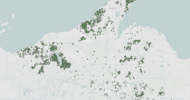Mother Nature Network | 12 February 2013
As a growing population stresses the world's food and water supplies, corporations and investors in wealthy countries are buying up foreign farmland and the freshwater perks that come with it.
From Sudan to Indonesia, most of the land lies in poverty-stricken regions, so experts warn that this widespread purchasing could expand the gap between developed and developing countries.
The “water grabbing” by corporations amounts to 454 billion cubic meters per year globally, according to a new study by environmental scientists. That’s about 5 percent of the water the world uses annually. Investors from seven countries – the United States, United Arab Emirates, India, United Kingdom, Egypt, China and Israel – accounted for 60 percent of the water acquired under these deals.
Most purchasers are agricultural, biofuel and timber investors. Some of the more active buyers in the United States, which leads the pack in number of deals, include multinational investors Nile Trading and Development, BHP Billiton, Unitech and media magnate Ted Turner, according to the study published last month.
Wendy Wolford, a professor at Cornell University who studies political and social impacts of international land deals, said while it is difficult to tease out investor motives, they “don’t grab land in places without access to water.” Some countries – including Indonesia, the Philippines and the Democratic Republic of Congo – had large amounts of water rights grabbed because they’re countries with a lot of rainfall.
Since 2000, 1,217 deals have taken place, which transferred over 205 million acres of land, according to the public database Land Matrix. About 62 percent of these deals were in Africa – totaling about 138 million acres, roughly the size of two Arizonas.
For countries reliant on farming and already suffering from poverty, the potential impacts are huge, said Paolo D’Odorico, a University of Virginia professor and co-author of the new report that estimates the water supplies at stake. About 66 percent of the total deals are in countries with high hunger rates.
“In many of these countries, the sum of the water being grabbed would be enough to eliminate malnourishment,” said D’Odorico, who collaborated with scientists from Italy’s Polytechnic University of Milan. Wolford said there is danger that local people – especially in places like sub-Saharan Africa – are not aware of land purchases and how it could affect their way of life.
“That’s probably the biggest problem – people could have gathered timber from the woods or lived downstream of the land grabbed,” Wolford said. “These things could be taken away without them knowing what happened.”
Food crisis, biofuels spur “grabbing”
Such land deals are often derisively dubbed “land grabbing,” which D’Odorico defines as a deal for about 500 acres or more that converts an environmentally important area currently used by local people to commercial production.
Land grabbing surged from 2005 to 2009 in response to a food price crisis, according to a 2012 report from Land Matrix, which is run by a group of organizations that advocate for land rights for the poor. Prior to 2008, international agriculture land deals totaled about 9 million acres purchased a year, according to the World Bank. In 2009, that shot up to 138 million.
And while that sharp spike has leveled off, the amount of deals still remains much higher than before 2005.
Jennifer Franco, a researcher at the Transnational Institute, an international think tank in the Netherlands that advocates for social justice, said land grabbing has been going on for a long time and some of the increase is due to more awareness and reporting of it. But experts say there have been global causes driving its growth in the past decade.
“One big driver is biofuels and new biofuel policy. It has really increased the demand for agricultural land,” D’Odorico said.
The 2007 Energy and Independence Security Act in the United States mandated a fourfold increase of the amount of biofuels by 2022. A 2009 European Union directive had a similar goal. Biofuels are fuels made from different types of plants and crops. The most popular examples from crops are turning corn or sugarcane into ethanol, or turning palm oil into biodiesel.
Wolford said that droughts in key grain-producing countries – such as the United States, Argentina and Australia – in recent years play a role as well. With dwindling yields, these richer nations buy up land in other places to secure their own food supply, she said.
She also pointed to the industrialization of agriculture over the past few decades. This type of farming needs a lot of land, which can be found cheaply overseas.
Local people may be neglected
There is little international policing of land deals.
“International corporations are subject to domestic and international trade rules and treaties, but when it comes to what a country does with its land, that strikes at the core of national sovereignty,” Wolford said.
In 2011, the Food and Agricultural Organization of the United Nations released voluntary guidelines, urging investors to first think about the rights and needs of the people and communities where the land is located. Franco said the guidelines were strongly framed by human rights. But they have no teeth.
“Capitalist firms are not Boy Scouts, and they are unlikely to place moral codes and ‘good governance’ above the interests and demands of their owners or shareholders,” according to a paper published last year by researchers at the International Institute of Social Studies in the Netherlands.
Few land deals have progressed to production, said Philip Woodhouse, a professor at the University of Manchester who specializes in social and political research in Africa. But some regions have already seen land deals spur water-driven tension.
A plantation in Ethiopia’s Gambela region, owned by a Saudi Arabian billionaire, diverts water from the Alwero River, according to a June 2012 report from GRAIN, a non-profit organization that advocates for small farmers. The Alwero River is important for thousands of people in the region – for farming and fishing. In April 2012, a group ambushed and killed five people at the Saudi billionaire’s company over Alwero diversions, according to the report.
D’Odorico’s study points to Sudan where land is usually grabbed on the banks of the Blue Nile – heavily sought after spots in an otherwise dry place. And while this may bolster overall farming capacity in regions, it pushes out small farmers.
In Sudan “the local population is becoming increasingly dependent on food aid and international food subsidies,” because the land grabbers are pushing out small farming, according to D’Odorico’s study.
Some of the land grabbed was savannahs and forests, suggesting that the grabbing also may contribute to deforestation in developing countries, D’Odorico’s said.
Land has become “a hugely sensitive political issue throughout Africa,” Woodhouse said. He said it is still unclear – with limited deals moving to production – if the deals will help or hurt small farmers. A 2011 study he co-authored found that while some investment in sub-Saharan Africa could strengthen water capacity for local people, the “impacts are likely to be far more extensive than might be anticipated from the area of land occupied.”
Who’s selling?
So why are governments interested in selling and leasing the land off to foreign investors?
Africa and Asia have accounted for 44 and 37 percent, respectively, of the total land grabbed since 2000. Nearly two-thirds of those acres are in Eastern Africa and Southeast Asia.
For many countries – especially in sub-Saharan Africa – the investors represent a potential to modernize their farming. About 79 percent of the land deals in Africa have been for agriculture.
It also represents an influx of money – especially as other funding seems to have eased up. Thirty percent of World Bank loans funded African agriculture in 1980; it dropped to 12 percent in 2010, according to Woodhouse's 2011 study.
And, while taking water that others need is a worry, investors could potentially drive improved water storage and distribution in regions that don’t have the money to make such improvements.
“Ultimately, the extent to which large land deals can generate real development, secure access to natural resources for all, and improve food security will depend on their terms and conditions,” said Jose Graziano da Silva, director of the Food and Agriculture Organization of the United Nations, at a 2012 Cornell University conference.
With the world population steadily rising, the United Nations has said that food production needs to double by 2050. But not everyone agrees large-scale investment and industrial farming is the way to improve global water and food capacity.
Who’s buying?
Most international land deals involve a tangle of different corporations and partnerships. A handful of the purchasers are countries, but most are investment firms, biofuel producers or large-scale farming operations.
Closely mirroring the top water grabbers, the top five countries by amount of land purchased since 2000 were the United States, Malaysia, the United Kingdom, China and the United Arab Emirates, according to Land Matrix data.
U.S. companies have grabbed about 777 million acres since 2000. The largest acquisition by a U.S. company was a highly publicized 1,482,632-acre purchase in Sudan by Texas-based Nile Trading and Development.
The firm purchased the land for about $25,000, and attained the rights to do whatever it pleased with it – natural resource extraction, mining, subleasing or farming. At least some of the land is used for palm oil – an ingredient for biofuel.
Other large U.S. purchasers include BHP Billiton, a large mining company that owns 877,000 acres in Indonesia, a country known for untapped mining potential, and media magnate Ted Turner of AOL and CNN fame, who owns 111,000 acres in Argentina, although it’s unclear if anything is farmed there.
The U.S. companies did not return requests for comment.
Agricultural producer and investor Cargill, which is listed in the LandMatrix report as owning 775,000 acres in Brazil for soybean production, never owned the land, according to spokesman Pete Stoddart. Rather, the company received crops from farmers on the land. This, too, has stopped, he said, since Cargill joined a soy moratorium created in response to an anti-deforestation report by Greenpeace.
Stoddart said overseas investment by Cargill is done in sustainable ways that address food security and help local people and communities.
The full impact of the global land grabbing is not clear because information on the deals and their water usage is sparse, D’Odorico said.
“Sure, this could be a way to bring in capital or create jobs for those who can’t grow their own economy,” D’Odorico said. “But there isn’t evidence that proves that. Here [his study] is evidence that this could lead to lost natural ecosystems, and people losing land they’ve relied on and water they need.”
As a growing population stresses the world's food and water supplies, corporations and investors in wealthy countries are buying up foreign farmland and the freshwater perks that come with it.
From Sudan to Indonesia, most of the land lies in poverty-stricken regions, so experts warn that this widespread purchasing could expand the gap between developed and developing countries.
The “water grabbing” by corporations amounts to 454 billion cubic meters per year globally, according to a new study by environmental scientists. That’s about 5 percent of the water the world uses annually. Investors from seven countries – the United States, United Arab Emirates, India, United Kingdom, Egypt, China and Israel – accounted for 60 percent of the water acquired under these deals.
Most purchasers are agricultural, biofuel and timber investors. Some of the more active buyers in the United States, which leads the pack in number of deals, include multinational investors Nile Trading and Development, BHP Billiton, Unitech and media magnate Ted Turner, according to the study published last month.
Wendy Wolford, a professor at Cornell University who studies political and social impacts of international land deals, said while it is difficult to tease out investor motives, they “don’t grab land in places without access to water.” Some countries – including Indonesia, the Philippines and the Democratic Republic of Congo – had large amounts of water rights grabbed because they’re countries with a lot of rainfall.
Since 2000, 1,217 deals have taken place, which transferred over 205 million acres of land, according to the public database Land Matrix. About 62 percent of these deals were in Africa – totaling about 138 million acres, roughly the size of two Arizonas.
For countries reliant on farming and already suffering from poverty, the potential impacts are huge, said Paolo D’Odorico, a University of Virginia professor and co-author of the new report that estimates the water supplies at stake. About 66 percent of the total deals are in countries with high hunger rates.
“In many of these countries, the sum of the water being grabbed would be enough to eliminate malnourishment,” said D’Odorico, who collaborated with scientists from Italy’s Polytechnic University of Milan. Wolford said there is danger that local people – especially in places like sub-Saharan Africa – are not aware of land purchases and how it could affect their way of life.
“That’s probably the biggest problem – people could have gathered timber from the woods or lived downstream of the land grabbed,” Wolford said. “These things could be taken away without them knowing what happened.”
Food crisis, biofuels spur “grabbing”
Such land deals are often derisively dubbed “land grabbing,” which D’Odorico defines as a deal for about 500 acres or more that converts an environmentally important area currently used by local people to commercial production.
Land grabbing surged from 2005 to 2009 in response to a food price crisis, according to a 2012 report from Land Matrix, which is run by a group of organizations that advocate for land rights for the poor. Prior to 2008, international agriculture land deals totaled about 9 million acres purchased a year, according to the World Bank. In 2009, that shot up to 138 million.
And while that sharp spike has leveled off, the amount of deals still remains much higher than before 2005.
Jennifer Franco, a researcher at the Transnational Institute, an international think tank in the Netherlands that advocates for social justice, said land grabbing has been going on for a long time and some of the increase is due to more awareness and reporting of it. But experts say there have been global causes driving its growth in the past decade.
“One big driver is biofuels and new biofuel policy. It has really increased the demand for agricultural land,” D’Odorico said.
The 2007 Energy and Independence Security Act in the United States mandated a fourfold increase of the amount of biofuels by 2022. A 2009 European Union directive had a similar goal. Biofuels are fuels made from different types of plants and crops. The most popular examples from crops are turning corn or sugarcane into ethanol, or turning palm oil into biodiesel.
Wolford said that droughts in key grain-producing countries – such as the United States, Argentina and Australia – in recent years play a role as well. With dwindling yields, these richer nations buy up land in other places to secure their own food supply, she said.
She also pointed to the industrialization of agriculture over the past few decades. This type of farming needs a lot of land, which can be found cheaply overseas.
Local people may be neglected
There is little international policing of land deals.
“International corporations are subject to domestic and international trade rules and treaties, but when it comes to what a country does with its land, that strikes at the core of national sovereignty,” Wolford said.
In 2011, the Food and Agricultural Organization of the United Nations released voluntary guidelines, urging investors to first think about the rights and needs of the people and communities where the land is located. Franco said the guidelines were strongly framed by human rights. But they have no teeth.
“Capitalist firms are not Boy Scouts, and they are unlikely to place moral codes and ‘good governance’ above the interests and demands of their owners or shareholders,” according to a paper published last year by researchers at the International Institute of Social Studies in the Netherlands.
Few land deals have progressed to production, said Philip Woodhouse, a professor at the University of Manchester who specializes in social and political research in Africa. But some regions have already seen land deals spur water-driven tension.
A plantation in Ethiopia’s Gambela region, owned by a Saudi Arabian billionaire, diverts water from the Alwero River, according to a June 2012 report from GRAIN, a non-profit organization that advocates for small farmers. The Alwero River is important for thousands of people in the region – for farming and fishing. In April 2012, a group ambushed and killed five people at the Saudi billionaire’s company over Alwero diversions, according to the report.
D’Odorico’s study points to Sudan where land is usually grabbed on the banks of the Blue Nile – heavily sought after spots in an otherwise dry place. And while this may bolster overall farming capacity in regions, it pushes out small farmers.
In Sudan “the local population is becoming increasingly dependent on food aid and international food subsidies,” because the land grabbers are pushing out small farming, according to D’Odorico’s study.
Some of the land grabbed was savannahs and forests, suggesting that the grabbing also may contribute to deforestation in developing countries, D’Odorico’s said.
Land has become “a hugely sensitive political issue throughout Africa,” Woodhouse said. He said it is still unclear – with limited deals moving to production – if the deals will help or hurt small farmers. A 2011 study he co-authored found that while some investment in sub-Saharan Africa could strengthen water capacity for local people, the “impacts are likely to be far more extensive than might be anticipated from the area of land occupied.”
Who’s selling?
So why are governments interested in selling and leasing the land off to foreign investors?
Africa and Asia have accounted for 44 and 37 percent, respectively, of the total land grabbed since 2000. Nearly two-thirds of those acres are in Eastern Africa and Southeast Asia.
For many countries – especially in sub-Saharan Africa – the investors represent a potential to modernize their farming. About 79 percent of the land deals in Africa have been for agriculture.
It also represents an influx of money – especially as other funding seems to have eased up. Thirty percent of World Bank loans funded African agriculture in 1980; it dropped to 12 percent in 2010, according to Woodhouse's 2011 study.
And, while taking water that others need is a worry, investors could potentially drive improved water storage and distribution in regions that don’t have the money to make such improvements.
“Ultimately, the extent to which large land deals can generate real development, secure access to natural resources for all, and improve food security will depend on their terms and conditions,” said Jose Graziano da Silva, director of the Food and Agriculture Organization of the United Nations, at a 2012 Cornell University conference.
With the world population steadily rising, the United Nations has said that food production needs to double by 2050. But not everyone agrees large-scale investment and industrial farming is the way to improve global water and food capacity.
Who’s buying?
Most international land deals involve a tangle of different corporations and partnerships. A handful of the purchasers are countries, but most are investment firms, biofuel producers or large-scale farming operations.
Closely mirroring the top water grabbers, the top five countries by amount of land purchased since 2000 were the United States, Malaysia, the United Kingdom, China and the United Arab Emirates, according to Land Matrix data.
U.S. companies have grabbed about 777 million acres since 2000. The largest acquisition by a U.S. company was a highly publicized 1,482,632-acre purchase in Sudan by Texas-based Nile Trading and Development.
The firm purchased the land for about $25,000, and attained the rights to do whatever it pleased with it – natural resource extraction, mining, subleasing or farming. At least some of the land is used for palm oil – an ingredient for biofuel.
Other large U.S. purchasers include BHP Billiton, a large mining company that owns 877,000 acres in Indonesia, a country known for untapped mining potential, and media magnate Ted Turner of AOL and CNN fame, who owns 111,000 acres in Argentina, although it’s unclear if anything is farmed there.
The U.S. companies did not return requests for comment.
Agricultural producer and investor Cargill, which is listed in the LandMatrix report as owning 775,000 acres in Brazil for soybean production, never owned the land, according to spokesman Pete Stoddart. Rather, the company received crops from farmers on the land. This, too, has stopped, he said, since Cargill joined a soy moratorium created in response to an anti-deforestation report by Greenpeace.
Stoddart said overseas investment by Cargill is done in sustainable ways that address food security and help local people and communities.
The full impact of the global land grabbing is not clear because information on the deals and their water usage is sparse, D’Odorico said.
“Sure, this could be a way to bring in capital or create jobs for those who can’t grow their own economy,” D’Odorico said. “But there isn’t evidence that proves that. Here [his study] is evidence that this could lead to lost natural ecosystems, and people losing land they’ve relied on and water they need.”














